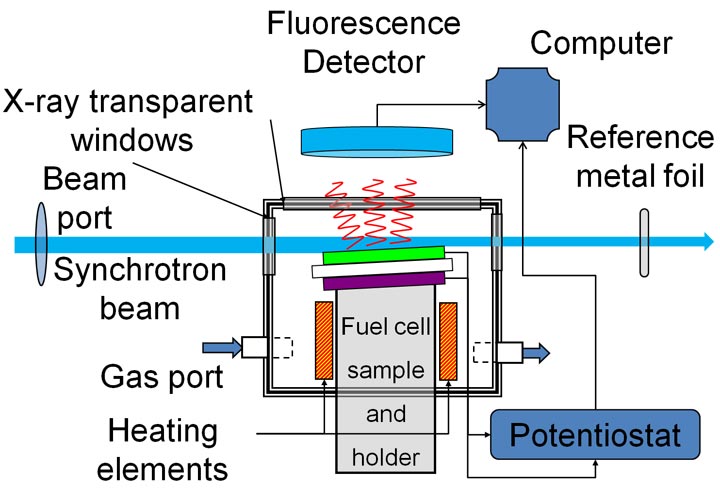X-rays from NSLS Reveal Fuel Cells in Action
Findings could improve durability of materials for transforming fuels to electricity
May 30, 2013
Wouldn't it be great to have a magical "energy box" that could convert a wide array of fuels to electricity with high efficiency and lower emissions? Solid oxide fuel cells (SOFCs) show significant promise. But these solid-state energy-conversion devices are made of complex materials and they require specific conditions for optimal operation—high temperatures, variable pressures, and electrical polarization.
Georgia Tech's Samson Lai explains the research
Some of those conditions and gases produced during the energy-conversion process can cause fuel-cell components to deteriorate over time. But studies of individual component materials and conditions in isolation don't accurately reflect what happens to fuel cells in operation. And studying solid-state fuel cells while operating is a challenge, because all the action takes place inside a high-temperature furnace.
"All of the interesting chemical reactions—the interactions between the fuel and the electrodes in the cell—all of that is kind of hidden from view," says Samson Lai, a graduate research assistant working under the advisement of professors Faisal Alamgir and Meilin Liu at the Georgia Institute of Technology.
"X-ray absorption spectroscopy provides … clues about the mechanisms of interaction between the electrode material and its environment."
— Samson Lai, Georgia Tech
To "see" inside the box, Lai and his Georgia Tech research team needed x-ray vision—the kind made possible by high-intensity x-ray beams at the National Synchrotron Light Source (NSLS), a research facility at the U.S. Department of Energy's Brookhaven National Laboratory that is open to scientists from universities, government, and industry.
"The x-rays coming out of a synchrotron are much brighter than what you would normally get out of a typical x-ray source that you might find on a college/research university level," Lai said.
The Alamgir and Liu research team designed a custom furnace to enable control over temperature, gas contamination, and electrical polarization that could be placed in the line of x-rays at NSLS beamline X18B. The device has two windows: one to allow x-rays to enter and interact with fuel cell components while it is operating; and one for fluorescent x-rays resulting from those interactions to carry information about electronic and structural characteristics to a detector outside the box.

Schematic of the custom-designed furnace used to test solid-state fuel cell components in action at beamline X18B at the National Synchrotron Light Source
The scientists call the technique operando spectroscopy—spectroscopic analysis of the active material performed while the device is operating.
"X-ray absorption spectroscopy provides both electronic and structural information with elemental selectivity, providing clues about the mechanisms of interaction between the electrode material and its environment," Lai said.
The data show that carbon dioxide and water vapor have different oxidation and reduction effects on different elements in the SOFC electrode, and those effects are different at high temperature from those observed at low temperature.
"These results clearly show why we need an element-specific operando technique to understand the combined influence of operating conditions on the material state of our fuel cell components," Lai said.
The ultimate goal for the experiments is to gain insight into how gas contaminants cause degradation.
"Solving some of the fundamental mysteries about SOFC electrode degradation, or poisoning, could help us rationally design and synthesize new materials that can directly protect against these detrimental processes, which should have significantly higher success than making best guesses from experience," Lai said.
This research was funded by the National Science Foundation and the HeteroFoaM Energy Frontier Research Center, one of 46 EFRC's funded by DOE's Office of Science. Operations at Brookhaven's NSLS are also supported by DOE's Office of Science.
DOE's Office of Science is the single largest supporter of basic research in the physical sciences in the United States, and is working to address some of the most pressing challenges of our time. For more information, please visit science.energy.gov.
2013-3988 | INT/EXT | Newsroom









